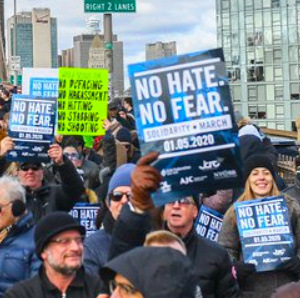When 25,000 people marched across the Brooklyn Bridge on January 5, a stirring response to a spike in anti-Semitic violence in the New York metro area, it was a meaningful display of support after weeks of media figures attempting to rationalize away the attacks.
Articles over the last week in vaunted media outlets such as The Atlantic, Washington Post, NBC News, Daily Beast and others suggested that the attacks can at least be partly explained by a rising Orthodox Jewish population, complex racial tensions, gentrification and socioeconomic grievance.
This is gaslighting at best. As random Jews are being murdered, shot, hacked and assaulted just for being Jewish, media commentators are already trying to create a false narrative that shifts blame from the assailants onto Jews for the crime of moving into and growing within minority communities.
The double standard here is glaring. When a white supremacist carries out an anti-Semitic attack, we’re quick to condemn the hateful, extremist ideology behind it. We ridicule the conspiracy theories that motivated it. We point our finger at the politicians and leaders who emboldened it. And we focus on the attacker’s bigotry rather than dwell on their grievances.
But when anti-Semitism emanates from a minority group, commentators — with a soft bigotry of their own — rush to strip the assailants of their agency and grasp for explanations other than those staring them right in the face: The Jersey City attackers were black supremacists who believed Jews were impostors that controlled the police and used them to carry out an agenda against black people.
The Monsey attacker, also black, searched the internet for “Zionist Temples” and “Why did Hitler hate the Jews.” Meanwhile, none of those arrested for anti-Semitic attacks in the past month have provided any motivation matching those ascribed to them by an overzealous media.
Even if such a motive were apparent, legitimizing it would also profess a double standard. When the (white) El Paso shooter said he was fighting a “Hispanic invasion of Texas,” no one thought it appropriate to explore the dispossession of whites as they become a minority in that state. And when the (white) Pittsburgh shooter said he targeted a synagogue there after a “Refugee Shabbat,” the media did not explore how the group the congregation supported does, in fact, help resettle immigrants and refugees in the United States. And rightfully so: such coverage would have almost justified the attacks. Somehow, though, media commentators do consider it appropriate to talk about the problems Jews cause by existing in (invading?) the wrong neighborhoods in the New York metro area.
Finally, let’s dispense with the political correctness for a moment and consider whether, as this narrative seems to suggest, cultural and socioeconomic upheaval in an area does lead to a surge in hate crimes.
The theory doesn’t pass muster. South Los Angeles (formerly South Central) has experienced an extreme transformation over the past three decades, where a once vibrant hub of black life and culture has been almost completely replaced by Latino life and culture. The shift has contributed to black poverty and homelessness, as employment rates and rates of home ownership among Latinos outpace their black neighbors. Yet there has been almost no racially motivated violence in that section of the city.
Or consider Worthington, Minn., which in the early 1990s was about 5 percent Hispanic. By 2010, chain migration increased the Hispanic population to more than 42 percent. Whites began self-segregating, while baseless rumors spread that the town was becoming more dangerous. Despite this, the town experienced no spike in hate crimes.
Even elsewhere in New York, ethnic strains abound without necessarily inviting hate crimes.
Ultimately, the narrative that racial tension contributes to anti-Semitism is more harmful than helpful. It explains very little, while offering no framework to help prevent these attacks going forward. It obscures other issues that we can actually do something about, like combating hatred at a communal level. And it risks inflaming community relations at a time when we need unity more than ever.

